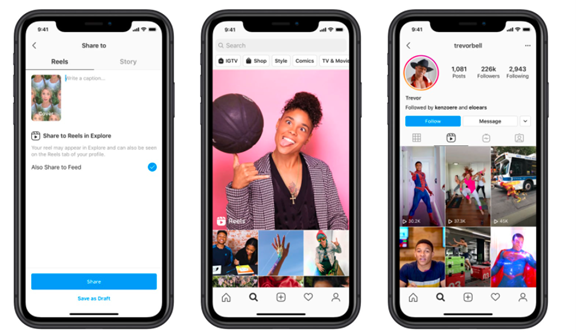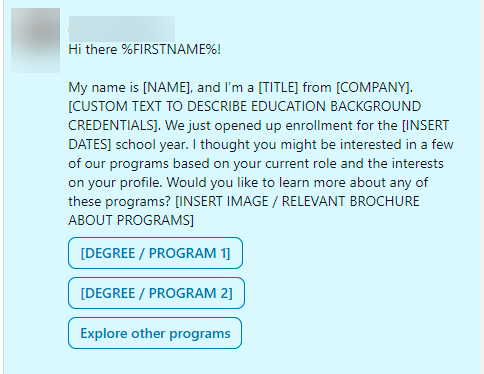
Predicting marketing trends in an ever-evolving digital landscape is always a challenge. With ongoing changes in technology, student behavior, and digital platforms, schools must stay agile to remain competitive.
To stay ahead, schools should closely monitor emerging platforms, evolving strategies, and broader industry shifts shaping the future of digital marketing. Here are just a few of the most intriguing.

1. Is the Future of Marketing… Depersonalized?
The first prediction in this list is also the boldest, which comes courtesy of marketing software provider Voluum. The idea that digital marketing will become less personalized may seem surprising, given the drive over the past few decades to make everything from advertising to content more targeted and tailored to individual users.
However, there may be something in the idea. Voluum cited an experiment from a Dutch broadcaster which found that ads which used contextual targeting rather than behavioural targeting – targeting based on a website’s content rather than user behaviours – yielded better results.
The thinking is that hypertargeted ads based on carefully crafted user profiles actually lock those users into a bubble that closes them off to new experiences they would otherwise try. Simpler targeting models, such as those based on keyword searches, are more likely to help advertisers tap into a wider audience.
Obviously, no school should dismiss personalization and behavioural targeting as strategies entirely, as they have proven and continue to prove to be effective approaches in the digital marketing realm. Nonetheless, it’s an interesting thing to think about. By only targeting prospects whose online usage patterns indicate they fit your audience, are you stopping a wider range of people from discovering your programs?
2. TikTok Ads: A Must for Schools?
Monetization is crucial to the growth of any emerging social network, and this usually means advertising. With over 2.3 billion downloads and counting, TikTok has truly captured the imagination of Gen Z social media users, and has looked to capitalize on this highly engaged, desirable audience by gradually introducing its own ads.
On this front, the social network has moved somewhat more quickly than previous rising stars like Snapchat. There is already a self-serve version of the platform, and TikTok offers five distinct ad types for users:
- In-Feed Ads
- Brand Takeover
- TopView
- Branded Hashtag Challenge
- Branded Effects
Example: An In-Feed Ad on TikTok from Adobe.

As desirable as advertising on TikTok might be, however, it is mostly the domain of larger companies at present. While the minimum campaign budget is just USD$50, an effective ad campaign can still wind up becoming very expensive, and thus smaller businesses – and most schools – haven’t found it to be an especially viable option thus far.
As the platform continues to mature, smaller advertisers are finding more cost-effective ways to achieve results. Making advertising more attractive to these accounts is crucial to TikTok’s long-term success and growth, so it’s in their interest to provide a better price point. Given the social network’s younger demographic is a crucial one for many schools, this could be good news for the education sector moving forward.
3. Instagram Reels vs. TikTok: The Competition Continues
Speaking of TikTok, this promises to be a pivotal year for the company, not just in terms of stewarding its own growth but also in staving off some new competition.
Just as they introduced Stories to combat the rise of Snapchat, Facebook has now launched its own version of TikTok in order to stop the Chinese company from eroding its market share. Instagram Reels, which allows users to create 15-second multi-clip videos overlaid with music and effects, apes the functionality of TikTok almost exactly.

At present, the feature is only available on Instagram, though it wouldn’t be a surprise if its parent company eventually rolled it out on its other networks like Facebook, Messenger, and WhatsApp.
For schools that are well-established on Instagram but yet to build a following on TikTok, Reels could be an interesting avenue to explore. However, that largely depends on how successful the feature is in winning back users from its rival. When Instagram launched Stories, usage soared in just a few months while Snapchat stalled and ultimately fell behind. Will Reels have a similar effect, or will TikTok prove a more worthy foe? In terms of digital marketing, it remains one of the most interesting trends to watch.
4. LinkedIn Conversation Ads Could Be Crucial to Your Higher Ed Digital Advertising Strategy
One of our favourite new innovations of 2020 was LinkedIn Conversation Ads. Essentially a chatbot that you can deliver to a prospect’s inbox with the targeting and budget capabilities of an ad, Conversation Ads served users with messages to drive specific objectives, then allowed advertisers to use chatflows to lead them to different replies based on their answers.
Most pleasingly of all, LinkedIn included a number of preset templates to make it easier for advertisers to build their ads, including a Drive Enrollment for Programs chatflow which is tailor-made for schools.

Many schools have already found some success with Conversation Ads, and it is expected to become a bigger part of the paid advertising spectrum. It may also be interesting to see if other social ad platforms follow LinkedIn’s lead on this front. Facebook does currently offer sponsored messages in Messenger which allow for Quick Replies and Buttons to be displayed to users (as well as chatbot integration), but the system isn’t as intuitive and user-friendly as what LinkedIn now offers. If Facebook were to up its game on this front, it could provide a great option for schools who like this idea but don’t have much of a potential audience on LinkedIn.
5. Local SEO Will Become Even More Important for Higher Education Marketing
Local SEO isn’t exactly a new higher ed digital marketing trend. Ever since Google began localizing results several years ago, it has been important for schools to ensure they optimize to rank highly in local searches.
As competition for students grows, schools must refine their local SEO efforts while also maintaining a strong digital presence to attract both local and international prospects.
6. Are We Seeing Fewer New Trends in Digital Marketing?
While this article has explored some of the exciting new innovations in digital marketing, it’s noticeable that there are fewer radically different trends than in some previous years.
A look at recent digital marketing trends reveals familiar themes—visual search, voice search, and TikTok remain prominent despite years of discussion.
In his own excellent article on next year’s trends, Smart Insights co-founder Dave Chaffey looks at Gartner’s 2020 Digital Marketing ‘Hype Cycle’ to illustrate this development:

“The innovation trigger part of the marketing curve is sparse, suggesting relatively few genuinely new technologies are emerging,” he points out. “This suggests to me that a maturity in tools has been reached and genuinely new techniques will be rare in future.”
This ‘no-trends’ trend has been evolving over the last few years and is arguably a natural consequence of the digital marketing sector reaching a new stage in its evolution. The big players like Google and Facebook are established, best practices are more tried and tested, and it’s harder to find innovations with the gravity to really make big waves in the marketplace.
For schools, this has both positives and negatives. On the negative side, it means fewer new ways to attract prospects. On the plus side, those with robust digital marketing strategies that follow established best practices can be more assured that they will continue to see results.
As always, it’s important not to get too carried away when looking at higher education marketing trends. Many of the ‘next big things’ in digital marketing over the years have petered out into nothing, and this could well be the case with Reels, Conversation Ads, or any other new innovations currently making waves.
Usually, the best approach is to be mindful of new ideas and innovations, while retaining your faith in proven approaches. Balancing innovation with proven strategies will enable schools to drive sustained growth while staying ahead in an ever-evolving digital landscape.






